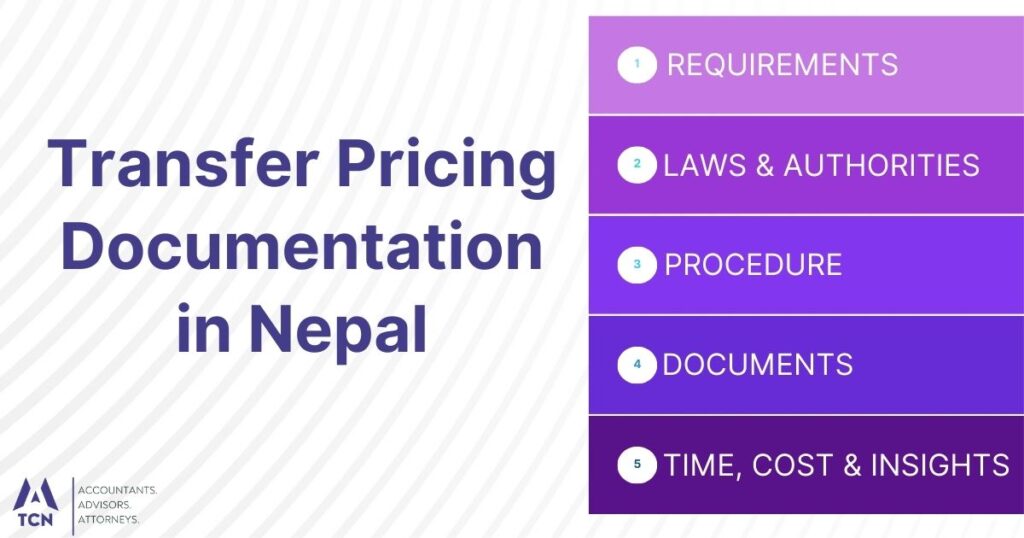Transfer pricing documentation is a crucial aspect of international taxation, especially for businesses operating across borders. In Nepal, as in many other countries, proper documentation of transfer pricing is essential to ensure compliance with tax regulations and to avoid potential penalties. This article provides a detailed overview of the transfer pricing documentation process in Nepal, aimed at helping businesses understand and fulfill their obligations.
What is the Purpose of Transfer Pricing Documentation?
Transfer pricing documentation serves several important purposes in the context of international taxation:
- Compliance: It demonstrates adherence to Nepal’s tax laws and regulations.
- Transparency: It provides a clear picture of a company’s cross-border transactions.
- Risk Assessment: It helps tax authorities evaluate the risk of tax avoidance.
- Justification: It supports the arm’s length nature of inter-company transactions.
- Audit Defense: It serves as a first line of defense in case of a tax audit.
- Internal Control: It aids in identifying and managing transfer pricing risks.
- Business Understanding: It provides insights into the company’s global value chain.
By maintaining comprehensive transfer pricing documentation, companies can demonstrate their commitment to tax compliance and potentially avoid costly disputes with tax authorities.
How to Prepare Transfer Pricing Documentation in Nepal?
Preparing transfer pricing documentation in Nepal involves several key steps:
- Identify Related Party Transactions: Review all cross-border transactions with associated enterprises.
- Gather Relevant Information: Collect financial data, contracts, and other supporting documents.
- Conduct Functional Analysis: Analyze functions performed, assets used, and risks assumed by each entity.
- Choose Appropriate Transfer Pricing Method: Select the most suitable method based on the nature of transactions.
- Perform Economic Analysis: Conduct comparability analysis and determine arm’s length prices.
- Prepare Documentation: Compile all information into a comprehensive report.
- Review and Update: Regularly review and update the documentation to reflect any changes in business operations or market conditions.
It’s crucial to start the documentation process early and maintain ongoing records throughout the fiscal year. This proactive approach ensures that all necessary information is readily available when it’s time to prepare the final documentation.
What Transactions Require Transfer Pricing Documentation?
In Nepal, transfer pricing documentation is required for various types of cross-border transactions between associated enterprises. These include:
- Sale or purchase of goods
- Provision or receipt of services
- Lending or borrowing of money
- Transfer or use of intangible property
- Sharing of costs or expenses
- Capital transactions (e.g., equity contributions, debt guarantees)
- Any other transaction that may affect the profit, income, loss, or assets of the enterprise
It’s important to note that even seemingly minor transactions may require documentation if they occur between related parties across international borders. Companies should maintain a comprehensive list of all such transactions to ensure full compliance.
What are Key Components of Transfer Pricing Report?
A well-structured transfer pricing report typically includes the following key components:
Executive Summary
A brief overview of the company, its transfer pricing policies, and key findings.
Company Overview
Detailed information about the company’s structure, business operations, and industry.
Functional Analysis
A thorough analysis of functions performed, assets used, and risks assumed by each entity involved in the transactions.
Economic Analysis
Description of the chosen transfer pricing method and its application, including comparability analysis.
Financial Information
Relevant financial data and segmented financial information related to the controlled transactions.
Intercompany Agreements
Summaries or copies of relevant intercompany agreements.
Conclusion
A statement confirming the arm’s length nature of the transactions based on the analysis performed.
Appendices
Supporting documents, charts, and detailed calculations.
Relevant Articles:
- How to Calculate and Pay Advance Tax in Nepal
- How to Apply for Tax Refund in Nepal
- How to Amend Your Income Tax Return
How Often Should Transfer Pricing Documentation Be Updated?
Transfer pricing documentation should be updated regularly to ensure its accuracy and relevance. In Nepal, it’s recommended to update the documentation:
- Annually: At the end of each fiscal year
- When Material Changes Occur: Such as changes in business structure or operations
- Prior to Tax Filings: To ensure consistency with tax returns
- Before Audits: If a tax audit is anticipated or announced
- After Significant Market Changes: When industry conditions shift dramatically
- When New Regulations are Introduced: To comply with any new requirements
- Upon Request by Tax Authorities: If additional information is required
Regular updates help maintain the documentation’s effectiveness in demonstrating compliance and supporting the company’s transfer pricing positions.
What are Penalties for Non-Compliance with Documentation?
Non-compliance with transfer pricing documentation requirements in Nepal can result in significant penalties. These may include:
- Monetary Fines: A percentage of the adjusted amount or a fixed sum
- Interest Charges: On unpaid taxes resulting from transfer pricing adjustments
- Double Taxation: If adjustments lead to income being taxed in multiple jurisdictions
- Reputation Damage: Public disclosure of non-compliance may harm business relationships
- Increased Scrutiny: Future transactions may face more intense examination
- Legal Consequences: In severe cases, legal action may be taken
- Loss of Tax Benefits: Non-compliance may result in the loss of certain tax incentives
To avoid these penalties, companies should prioritize timely and accurate preparation of transfer pricing documentation.
How to Conduct Comparability Analysis for Documentation?
Comparability analysis is a crucial step in transfer pricing documentation. It involves comparing the controlled transactions with similar uncontrolled transactions to determine arm’s length prices. Here’s a step-by-step process:
Step 1: Identify the Controlled Transactions
Clearly define the transactions between related parties that need to be analyzed.
Step 2: Understand the Economically Relevant Characteristics
Consider factors such as contractual terms, functional analysis, economic circumstances, and business strategies.
Step 3: Review Internal Comparables
Look for similar transactions between the company and unrelated parties.
Step 4: Search for External Comparables
Use databases and public information to find comparable transactions between unrelated parties.
Step 5: Select Appropriate Comparables
Choose the most relevant comparables based on similarity to the controlled transaction.
Step 6: Make Adjustments
Adjust for any material differences between the controlled and uncontrolled transactions.
Step 7: Determine the Arm’s Length Range
Calculate the range of acceptable prices or profit levels based on the comparable data.
This process ensures that the transfer prices used in controlled transactions are consistent with those that would be used between unrelated parties under similar circumstances.
What Methods are Used in Transfer Pricing?
Transfer pricing methods are used to determine whether the conditions of commercial and financial relations between associated enterprises are consistent with the arm’s length principle. The main methods include:
- Comparable Uncontrolled Price (CUP) Method
- Resale Price Method
- Cost Plus Method
- Transactional Net Margin Method (TNMM)
- Profit Split Method
- Other Methods (when approved by tax authorities)
Each method has its strengths and is suitable for different types of transactions. The choice of method depends on factors such as the nature of the transaction, availability of reliable data, and degree of comparability between controlled and uncontrolled transactions.
How to Justify Arm’s Length Pricing?
Justifying arm’s length pricing is crucial in transfer pricing documentation. Here are key steps to ensure your pricing is defensible:
- Choose the Most Appropriate Method: Select the transfer pricing method that best fits your transaction type.
- Conduct Thorough Comparability Analysis: Identify and analyze comparable uncontrolled transactions.
- Use Reliable Data: Ensure all financial and operational data used is accurate and verifiable.
- Document Your Process: Clearly explain your reasoning for choices made in the analysis.
- Consider Multiple Years of Data: This can help account for business cycles and special circumstances.
- Apply Statistical Tools: Use interquartile ranges or other statistical measures to determine an acceptable price range.
- Explain Any Deviations: If your prices fall outside the arm’s length range, provide a detailed explanation.
By following these steps and maintaining comprehensive documentation, you can build a strong case for the arm’s length nature of your transfer prices.
What is the Deadline for Documentation Submission?
In Nepal, transfer pricing documentation should be prepared contemporaneously and submitted to the tax authorities upon request. Key points to remember:
- Preparation Deadline: Documentation should be ready by the tax return filing date.
- Submission Timeline: Usually within 30 days of receiving a request from tax authorities.
- Annual Requirements: Some information may need to be submitted annually with tax returns.
- Extended Deadlines: In complex cases, extensions may be granted upon request.
- Advance Pricing Agreements: Different timelines may apply for APAs.
- Country-by-Country Reporting: Separate deadlines may exist for CbC reporting, if applicable.
- Penalties for Late Submission: Failure to submit on time can result in penalties.
It’s crucial to maintain up-to-date documentation and be prepared to submit it promptly when requested. This proactive approach helps avoid penalties and demonstrates compliance with Nepal’s transfer pricing regulations.
Get in Touch with Us
Our team consists of Chartered Accountants, Corporate Lawyers and Chartered Financial Analysts. Our Firm is renowned for provide expert legal, tax and financial services. Contact us for Quick Legal and Tax Consultation.
📧 Email: info@taxconsultantnepal.com
📞 Phone: +977 9709090127
📍 Location: Sinamangal Marga, Old Baneshwor, Kathmandu, Nepal
You can contact us via email, contact form, or phone call. We are also available on WhatsApp, Viber, Telegram, and WeChat for your convenience. Feel free to drop your queries, and our professionals will get back to you promptly.


